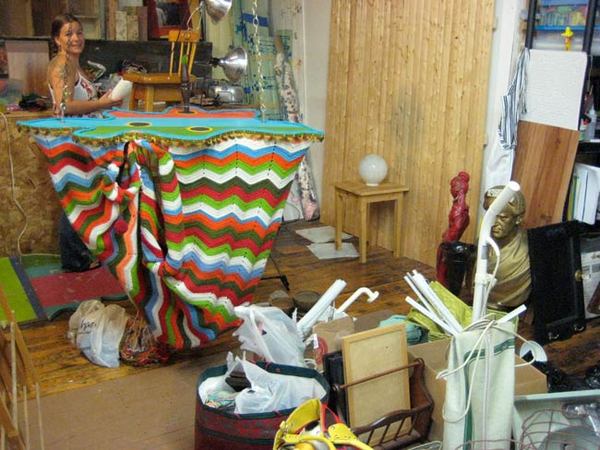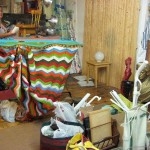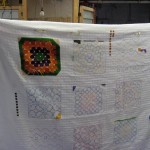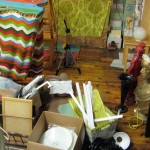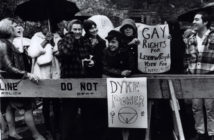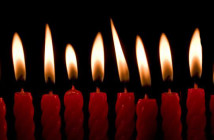Samantha Fields makes complex and intricate sculptures and installations that are overwhelmingly crafty, undeniably kitschy, and that seem to revel in their beautiful ugliness. This summer, we sat down among the mountains of Afghans, beads, curtains, kitchen sinks and other objects in her studio to talk about her current projects, Girl Scout badges and Easy-Bake Ovens.
SF: I started as a fibers major, weaving and dying and using the finest materials. It was forbidden to move into acrylic yarn and things like that. It was always linen and silk, and craft had to be of utmost importance. That's all fine and good, and results in beautiful things, but by the time I got to grad school I wanted nothing to do with it. I was tired of it, and at the time there weren't very many artists using fiber in a contemporary way. There was a huge distinction between the craft and what was considered contemporary.
So I just started building stuff out of wood, and making sculpture and wanting nothing to do with my textiles background, but it crept back in. Also, the subject matter started to be more about my own family. I grew up doing arts and crafts with my mom, who was a Girl Scout leader, and the only badge we ever got was the craft badge. So I started using all the materials I used as a kid as part of my work.
I think that's where some of the kitsch comes in, and I love it! I love really bad colors, and I love glitter. It's kitschy in a great way!
MN: You're not entirely working in fabrics, I remember a video piece in the Art House a few years ago. Are you doing more video?
SF: No. I mean, I could, it's always rolling around in my head. Right now I'm working more on trying to include some photography with the installations, along with some sound.
MN: We were just poking around your studio, looking at the new work you have underway. Can you describe what you are up to?
SF: There are two major projects right now.The first comes out of, well I was cleaning my studio and I realized how many materials I've collected: furniture pieces, trim, Afghans -- I probably have about 200 Afghans -- and just tons and tons of materials that I haven't been using. So I decided that I can only use what I have in my studio. Then I wanted to open it up, so I sent out a gazillion emails asking for people to give me their discarded household objects, anything but clothing that I could carry. I am documenting each object, recording where I got it, when I got it, what it is and why it was discarded. I'm photographing each object, and then using them to create sculpture and installations.
I'm in the very beginning stages of the project. I'll be collecting for a long time, and I'm just starting to photograph the objects now, and I have plans for a bunch of them as sculptures.
MN: What kind of objects have you been getting?
SF: I have a bathroom sink, which has to be a fountain, of course. I have pumps left over -- I'm sacrificing a lot of my older work and I can take pumps from some past sculptures. I have a bathroom shower door. There is a great bust of Governor Winthrop, the first Governor of Massachusetts, a fertility goddess, and lots of broken shades, pot holders, all kinds of random objects.
The other project is more of a collaborative or community-based piece, called "The Circus Project". Eventually, the big picture is three large structures that are a cross between tent and house, and I want to ask other artists to participate in filling these structures, and creating things inside them. Performance, sculpture, sound, 2D, all kinds of work.
So I'm starting on the first structure right now, which is the meeting house. It's the one structure that will be a space for people to come and make objects in. Probably crafty projects, or with Easy-Bake Ovens... I have a vision of lots of Easy-Bake Ovens.
MN: One theme that seems to run through a lot of your work is this notion of covering, or protecting, hiding and obscuring with curtains and blankets. Is that a motherly intention, a protective instinct, or something else?
SF: I don't know if it's a protective thing, a lot of the blankets I use end up being taken apart. With the Afghans, I think that they are a great metaphor for a family, because they are really ugly, but we love them and we don't know what to do with them, and somebody made them for us so we have to keep them. I think that's part of the reason I use them.
Most of the objects I use are also things that are broken or discarded, so it's really more about collecting these things that were precious to somebody, or were important at one point, and fixing them, putting them back together, reconstructing them.
MN: Looking at your work, I keep thinking about how craft functions, what it's supposed to do. I remember doing a lot of crafts as a kid, but the goal was never the final product, it was about learning some history or being with other people...
SF: Exactly. Part of "The Circus Project" involves my going around to other communities and asking people to cross-stitch the ceiling of the tents. I'm collecting their stories, in audio and written form, about objects they grew up with. It really is about coming together and doing something busy together, so it's more about community.
I think that just making stuff can be empowering. Even if it's Shrinky-Dinks, it engages a part of you that, if you carry it further, it can be empowering.
- Fields, among the many objects in her studio.
- Fields holds up one of the cross-stitched panels from her “Circus Project”
- Various objects and items donated to Fields
All images are by the author.

